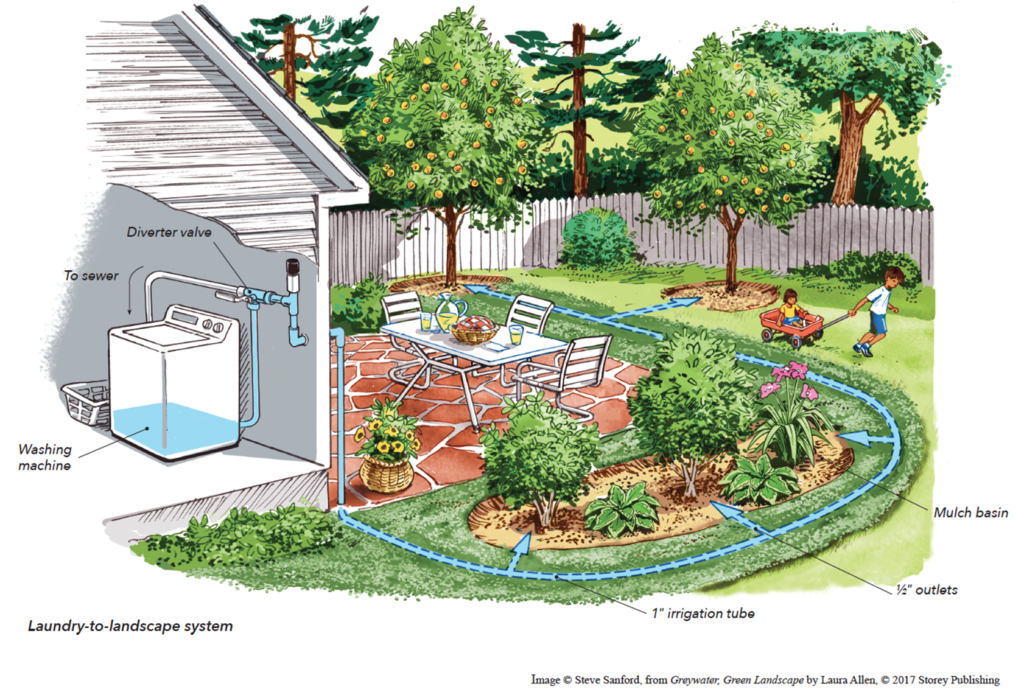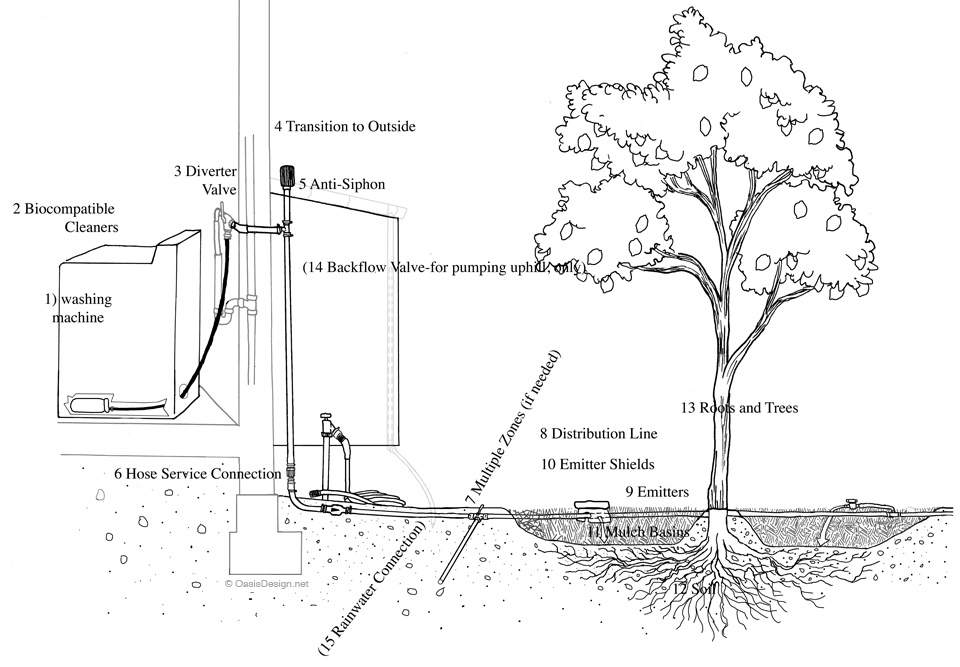Greywater can be the New Blue

Here in California, fruit hangs heavy on the vines
And there's no gold, I thought I'd warn you
And the hills turn brown in the summertime…
Kate Wolf Tweet
Drought has become the “new normal” in California. Currently, the National Integrated Drought Information System categorizes 97.5% of state land as being in “severe drought” (D2) or worse. Further, global climate change is causing dry periods (and other extreme weather) to become more frequent at an astonishing pace.
A simple way we can save water for ourselves and our community in California’s new reality is to consider recycling greywater (also spelled grey water, graywater, gray water). Greywater is any used household water that is non-potable (unsafe for drinking by humans) but hasn’t contacted toilet waste. Greywater can irrigate landscapes without undergoing any treatment.
It’s possible to start a home greywater system, specifically a Laundry to Landscape (L2L) system, quite cheaply (e.g. bring an empty bucket with you when you take a shower, let it fill, and use it to water your home landscape); later you may see opportunities to expand your home L2L scheme and expand your general greywater knowledge. (Used water that can possibly have contacted toilet waste is considered blackwater; it’s unsafe for recycling for any purpose without treatment.)
History
In the first decade of this century, Bay Area residents who wanted to recycle greywater, like the founders of Greywater Action (formerly Greywater Guerillas), faced an onerous plumbing code that discouraged construction of greywater systems, even though they were legal under a 1997 California law. Many worked around expensive and prohibitive code guidelines by simply designing systems that violated code and daring law enforcement to charge them. Today, a large proportion of California greywater systems still violate rules.
In 2009, California finally amended its plumbing code (California Plumbing Code, Chapter 16A: Non-potable Water Reuse Systems) in order to simplify it, making it much simpler to implement basic greywater systems.
Read here about the legal history of greywater in California.
Basic System Overview
Art Ludwig of Oasis Design pioneered the fundamental Laundry To Landscape (L2L) system (diagram). Here are excerpts from an instructional video by Oasis Design on the subject.
Some essential L2L components:
- 3-way diverter valve: washing machine wastewater flows in; a control on the valve switches between either flowing to the sewer drain, or being diverted into your L2L irrigation system.
- Air admittance valve (anti-siphon): This provides your system with necessary and effective venting.
- PVC or HDPE pipe: High-density polyethylene (HDPE) usually doesn’t have the risk of toxins like PVC can, but PVC is cheaper and more available. Your home may already be using PVC pipe elsewhere in any case.
- Mulch basins: These are trenches dug around the roots of each plant served by the system. See a design for a mulch basin for a single plant here. The shield protects the outlet from the tubing (emitter) from becoming clogged with mulch.
You can watch a video excerpt about maintaining your greywater system by Greywater Action.
Useful Tips
- The level of the diverter valve, and hence the attachment of the L2L system to the drainage and irrigation systems, should be above the normal water level in the washing machine to avoid creating an unwanted back-siphon effect while using the washing machine.
- For health reasons, do not allow greywater to collect and rest at any point in the system for over 24 hours.
- Greywater itself isn’t entirely safe to drink; to avoid directly consuming greywater, only water the roots of plants. Plants with edible roots aren’t suitable for gardening with greywater. Make sure all edible portions of the plants stay above the soil.
- Greywater toilet flush systems also exist, but aren’t recommended for beginners; directing greywater into the toilet tank can create an unintended back-siphon of greywater into your potable water supply.
- California categorizes kitchen sink drainage, dishwasher drainage, and diaper wash water as blackwater, and therefore not reusable. Other drainage is recyclable greywater (washing machines, showers, bathroom sinks, dehumidifiers).
- For an effective gravity flow system, piping should descend at 1 inch per 8 feet of pipe, or ⅛ inch per foot.
Green Shoots
Most of the major water providers in the Bay Area have rebates for both home and commercial greywater systems or their components or are strongly considering coming out with programs. Some home programs:
- San Francisco Public Utilities Commission (SFPUC)
- Up to $100 off 3 essential home greywater system components:
- PVC pipe
- 3-way diverter valve
- air admittance valve
- Up to $100 off 3 essential home greywater system components:
- East Bay Municipal Utility District (East Bay MUD)
- Valley Water
- BAWSCA
- Considering introducing a greywater program
Bay Area Greywater Contractors
Keep in mind that plumbers who do not work with greywater system contractors may or may not be able to provide effective quality assurance for your system design and the work you’ve done on it.
Links
- Laundry to Landscape (L2L) Grey Water System –Excerpts from Instructional Video by Oasis Design
- NYT: The Dirty Water Underground (2007)
Greywater Action: Maintaining your greywater system

